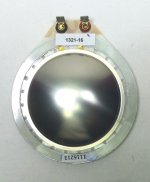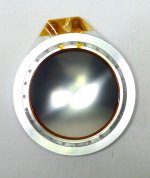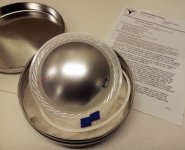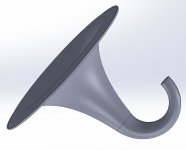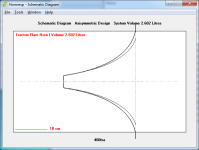With the historical info gathered over the last 24 hours I could probably fill the next 20 pages, but I won't 
Sometimes it is (also) good to read the opinions of very experienced people, such as Philip Newell.
During his R&D work on studio engineering and specifically studio monitor speakers, he found that the aluminum membranes of the Emilar EA / EK 175 were better suited to the sound of paper cone woofers than even the TAD Beryllium drivers.
Jonas Renkus was an audio legend and a genius. One of his last projects was the development of the Emilar EC320.
If you know what it takes to get the best / smoothest / most 'natural', or musical sound from a compression driver, and have a look at the diaphragm below, it is clearly pure technical art. Probably a bit too delicate for modern PA torture, but almost perfect for domestic use.
Sometimes it is (also) good to read the opinions of very experienced people, such as Philip Newell.
During his R&D work on studio engineering and specifically studio monitor speakers, he found that the aluminum membranes of the Emilar EA / EK 175 were better suited to the sound of paper cone woofers than even the TAD Beryllium drivers.
Jonas Renkus was an audio legend and a genius. One of his last projects was the development of the Emilar EC320.
If you know what it takes to get the best / smoothest / most 'natural', or musical sound from a compression driver, and have a look at the diaphragm below, it is clearly pure technical art. Probably a bit too delicate for modern PA torture, but almost perfect for domestic use.
Attachments
Last edited:
Well that answers that. Software helps to bridge the gap, I guess, though correlation does not equate causation, I still agree, where one is willing to go the distance in one area, they might, in another. Another philosophy says you don't need to know everything, you just need to know where to get the information you need, when you need it lol!
Thanks for the info Allen
Wesaygo, so what you thinking? I'm downloading Fusaion360, thanks for the heads up on that.
Warping seems to be defeatable but what do I know. Maybe if I print inside a small room with a space heater on blast, I could print at speed without an issue?... My buddy told me to go join a 3d printing forum, not a bad idea. I think I might be on to something. Lets the horn is facing exit up, opening down on the ground plane, slice the horn on the X axis's into layers, so no you have many round layers of horn, then chop those into reasonable sized segments along the y axis....just about any at 3d printer could handle this. Lets say the last layer at the opening is 36" in diameter, thats 113" in circumference, and at 5" segments thats 22 pieces....if the printer can print 5" inches high then you can break the horn into 5" layers, so lets say the horn is 35" long thats 6 layers. 3d printing is so conforming you could design the pieces to "fit" together in some kind of way. Might have to fill each piece with sand individually, but once assemble using maybe super glue if needed, then coat the whole thing in resin epoxy? Am I crazy or did I come up with a good idea? What do you guys think?
Thanks for the info Allen
Wesaygo, so what you thinking? I'm downloading Fusaion360, thanks for the heads up on that.
Warping seems to be defeatable but what do I know. Maybe if I print inside a small room with a space heater on blast, I could print at speed without an issue?... My buddy told me to go join a 3d printing forum, not a bad idea. I think I might be on to something. Lets the horn is facing exit up, opening down on the ground plane, slice the horn on the X axis's into layers, so no you have many round layers of horn, then chop those into reasonable sized segments along the y axis....just about any at 3d printer could handle this. Lets say the last layer at the opening is 36" in diameter, thats 113" in circumference, and at 5" segments thats 22 pieces....if the printer can print 5" inches high then you can break the horn into 5" layers, so lets say the horn is 35" long thats 6 layers. 3d printing is so conforming you could design the pieces to "fit" together in some kind of way. Might have to fill each piece with sand individually, but once assemble using maybe super glue if needed, then coat the whole thing in resin epoxy? Am I crazy or did I come up with a good idea? What do you guys think?
If you know what it takes to get the best / smoothest / most 'natural', or musical sound from a compression driver, and have a look at the diaphragm below, it is clearly pure technical art.
Renkus, Emilar, Community and Radian share same type of diaphragm design / r&d people. aluminum with soft surround now some with added beryllium . I have a collection of drivers from these sources. Some are great some are bad designs
Am I crazy or did I come up with a good idea? What do you guys think?
Is this for the mid high horn? What driver?
POOH, this is the second time within 24 hours that such a coincidence occurs
Do you happen to have any measurements of the 835 with the HR9045?
I will shortly my old laptop bit the bullet and I an configuring this new one and will bring over some files and produce new. I would not say it is the best driver ever in the world but it is the best used in the 9040 horn. I have used many and these horns. It has high synergy and only needs a 3-4 db pad so it is as sensitive as the midbass horn.
Yes it is. Driver is Axi2050.Is this for the mid high horn? What driver?
Am I crazy or did I come up with a good idea? What do you guys think?
It could work the way you describe. I would have concern about solidity of assembly with just epoxy and glue ( given predicted size of horn). Maybe reinforce it with laminated glassfiber or carbon fiber.
It could be interesting to see with someone (or a forum) involved in remote controlled miniature aircraft build ( they use composite /epoxy technics for wings and other odd shaped piece with high mecanical constraints) or find a surf shaper for advice if you are located near ocean.
Otherwise, yes you are crazy... can't wait the outcome.
Last edited:
Yes it is. Driver is Axi2050.
Ha, maybe return to the WE555 snail of the 20th century?
A horn usable to 300 cycles with low coloration and controlled radiation is as low as I'd advise go with a compression driver. I have used compression drivers up to a 10" diaphragm and found no benefit to go any lower. Besides the horn itself will be difficult to even build (as you are debating) and to integrate into most homes.

I would not say it is the best driver ever in the world but it is the best used in the 9040 horn. I have used many and these horns. It has high synergy and only needs a 3-4 db pad so it is as sensitive as the midbass horn.
Obviously, it's about the driver and the horn used with it. A severe mismatch between - in themselves - good horns and drivers will lead to suboptimal results.
Ha, maybe return to the WE555 snail of the 20th century? [/IMG]
Perhaps jzagaja can provide some support in this regard.
I was thinking, if I printed it, I could make it hollow, cut into layers and the layuers into segments, print those out, assemble them, and then fill them with sand as well. Seems that 3d printing has its own challenges main...warping?
Docali, who are you thanking? My thanks goes out to you for sharing though. Sounds like the files sent are not the ones to use because of artifacts?
I never calculated such large profiles before, so the point cloud is not optimal. I could adjust some settings to get a better point cloud. Especially with higher Lame exponents for the squared profiles it is a challenge to fill the outer extremes with points and not to overload other regions.
Before you think about building such a horn you should mention your favored shape of the shown versions. Then I would suggest a proof of concept by simulation like this:
DrBA Calculator and BEM Simulation – Sphericalhorns
We could ask Don if he prepares the ABEC project files.
This is a good point, I'm reasonably convinced tractrix works by its uncanny similarity to a LeCleach with a low T factor and an incomplete roundover. Hence I deprecate tractrix.The tractrix profile was never intended for horns while the spherical wave horn was.
I would not rate the tractrix that hard as you 
I had some funny mathematical exercise here and proposed a variation:
A True Expansion Tractrix Horn – Sphericalhorns
As i own a traxtric 400Hz horn I would not say that it sounds bad. But it has some characteristics I cannot accept over a long time.
I had some funny mathematical exercise here and proposed a variation:
A True Expansion Tractrix Horn – Sphericalhorns
As i own a traxtric 400Hz horn I would not say that it sounds bad. But it has some characteristics I cannot accept over a long time.
Perhaps jzagaja can provide some support in this regard.
I'm setting up production out of wood, rectangular. Lot of request for Sato 100Hz and 200Hz. below is JMLC-100 T0 bent like Sato. It's 1 meter mouth horn.
Attachments
This is very good. For a long time I wondered whether anyone would do this. I thought I could see where this is going, so I did a quick comparison of tractrix and LeCleach, to compare to your profiles.I had some funny mathematical exercise here and proposed a variation:
Attachments
I never calculated such large profiles before, so the point cloud is not optimal. I could adjust some settings to get a better point cloud. Especially with higher Lame exponents for the squared profiles it is a challenge to fill the outer extremes with points and not to overload other regions.
Before you think about building such a horn you should mention your favored shape of the shown versions. Then I would suggest a proof of concept by simulation like this:
DrBA Calculator and BEM Simulation – Sphericalhorns
We could ask Don if he prepares the ABEC project files.
I am ok with the spherical and the non progressive T. Better loading means lower group delay and less excursion which in turn means better resolution. Its flare is less, like the Tractrix as opposed to the JMLC, so loading freq vs resulting Fc is more efficient as well. I am trying to take full advantage of my size constraints so maybe you can lower the T in order to reach a horn that is 36" (914mm) long and near 31" (787mm) wide?
I'm setting up production out of wood, rectangular. Lot of request for Sato 100Hz and 200Hz. below is JMLC-100 T0 bent like Sato. It's 1 meter mouth horn.
I seen your listing on the internet. Can you explain what this type of horn is used for and why the other horns are not commonly found in these sizes? I know that this horn is made for a driver like the axi2050 but then why are so many people under the belief that no one wants to cross a horn so low? Obviously there's a market for it with the Sato style horn. Also, what are the short comings of bending the signal path? I assume there must be some type of drawback.
In the listing I see these are coming out of Germany. The shipping from Germany seems to be always cheaper vs the shipping from Poland, maybe this is the route for me....maybe.
Last edited:
The drawback of the bend/spiral is attenuation of the higher frequencies.
An additional drawback is that higher frequencies need longer to travel through snail honrs because of more reflections if the wave length becomes small compared to the section wise diameter.
I am ok with the spherical and the non progressive T. Better loading means lower group delay and less excursion which in turn means better resolution. Its flare is less, like the Tractrix as opposed to the JMLC, so loading freq vs resulting Fc is more efficient as well. I am trying to take full advantage of my size constraints so maybe you can lower the T in order to reach a horn that is 36" (914mm) long and near 31" (787mm) wide?
You guy seem to be a little bit positively crazy
What you intend is something I would recall as trumpets of Jericho. But it has been written down it should happen so:
View attachment swh_160_t071_jericho.zip
- Home
- Loudspeakers
- Multi-Way
- Is it possible to cover the whole spectrum, high SPL, low distortion with a 2-way?
